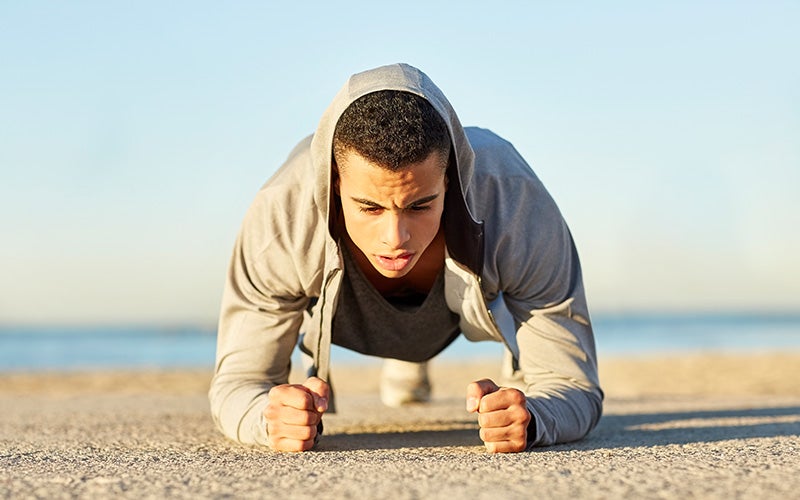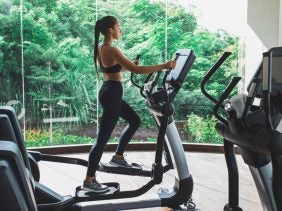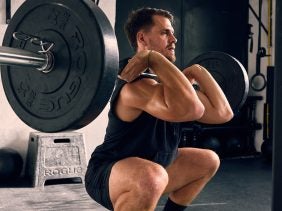To Build Strong Shoulders, Core, and Endurance, Hit the Plank
 ©Nomad
©Nomad
You’d think a workout buddy hyping you up would be most useful when you’re trying to, say, hit a deadlift PR or shave off a few seconds of your fastest track mile. And, sure, having a cheerleader is always awesome. But when they really come in handy is the last 10 seconds of a long, torturous, tremor-inducing plank. Because those 10 seconds last forever.
But it’s not in vain. Planks are one of the best bodyweight exercises that are certainly core-intensive, but work your whole body—including traps, shoulders, glutes, chest, front thighs, and hamstrings. And we weren’t kidding when we said that if you find it easy, you’re not doing it right. Technique is the biggest up-front challenge of planks.
Why is core training key?
Core muscles are, well, core to your overall body function. They’re there when you want to shove a stuffed suitcase into the overhead compartment, balance on a small boat on a wave-filled day, and transport pallets of dog food from the trunk to the garage. If you like to do lifting—deadlifts, cleans, snatches—those power moves will only benefit from a stronger core. For many people who use a wheelchair or other mobility aid, the core can be an important part of stabilizing, balancing, and producing force in order to get around. Having a core that’s on the weaker side can also be a factor in lower back pain, something that affects millions of Americans and has only gotten worse in our desk jockey work culture. If you have experienced back pain in the past, you know how debilitating it can be. And, paradoxically, it’s not really about treating the back at all. It’s about addressing the entire torso.
Let’s break it down.
There are two types of planks, high and low, and it just refers to what you do with your arms. So let’s kick things off with low planks. Start on a padded surface like a yoga mat or gym floor. (You can also fold a yoga mat over or use a towel under your arms for extra cushioning.)
Place forearms on the floor, and step both feet back, toes on the floor, legs locked out. You can keep your feet close together, which makes the plank harder, while placing them further apart provides additional stability and makes the plank easier. Keeping shoulders over elbows, think about making a straight line that starts with your heels, extends across your legs, butt, and back, and ends up your neck at your head. Keep your gaze on the floor but a little bit ahead of you. This will help you maintain a neutral neck and sustain the correct alignment. A high plank looks for that same alignment, but rather than forearms on the ground and elbows under shoulders, you’ll place your hands on the ground, creating a perpendicular line with your arms from the floor.
If a plank feels too challenging for you at the moment, try dropping your knees to the ground with thighs directly under hip sockets. Play with the distance between your knees and your arms. You don’t want to be too scrunched up so your back arches. You’re looking for an elongated back and comfortable stability.
The place where things are most likely to go wrong is in the alignment. If the plank feels too easy, it’s probably because your butt is in the air. Drop your hips and step your feet back slightly, if necessary. (This is where a trainer or a buddy comes in handy, as they’ll be able to diagnose your form in a flash.) The other alignment issue is having a hollow back, which is due to, you guessed it, not enough core strength. Think about pulling your belly button into your spine, and activating your glutes.
Doing a plank with proper form for 10 seconds is more useful than doing a poorly executed one for a minute. The only way you’re going to max out the benefits and avoid tweaking anything is by using the proper alignment.
Refuel: Try a whey protein shake
Spicing up those planks with six variations
Ready to add a little hot sauce to your ab workout? Here are six different takes on the plank. Pick two or three of them to try, and do two or three sets of each.
1. Military plank
Start in a high plank. Moving the torso and legs as little as possible, bend left arm and place left forearm on the floor, then repeat on right. From there, place left hand under left shoulder and push up, then repeat on right. Switch sides and repeat. That’s one rep. 10 rep equals 1 set.
2. Single arm plank
Start in a high plank, feet slightly wider apart. Raise right arm and point fingers forward. Hold for 5 to 15 seconds. Switch sides and repeat. That’s one rep. 2 reps equal one set.
3. Superman plank
Start in a high plank. Lift right arm and point fingers forward while you lift right leg and point toes back. Hold for 1 to 3 seconds. Switch sides and repeat. That’s one rep. 10 reps equal one set.
4. Bent knees side plank
Start lying on your side, resting on your forearm, elbow below shoulders, forearm perpendicular to your body, palm on floor. Bend knees 90° so that your knees are aligned with your torso and head, shins are behind you, and feet are stacked. Press through your forearm and raise hips toward ceiling. Hold for 5 to 15 seconds. That’s one rep. 5 reps equal one set. Do all reps on same side before switching sides.
5. Side plank
Start lying on your side, resting on your forearm, elbow below shoulders, forearm perpendicular to your body, palm on floor, feet stacked. Press through your forearm and raise hips toward ceiling. Hold for 5 to 15 seconds. That’s one rep. 5 reps equal one set. Do all reps on same side before switching sides.
6. Side plank with reach-through
Start in a side plank. When your hips are high, reach your free arm toward the ceiling, then rotate torso toward floor and reach arm under body. Reverse and return to start. That’s one rep. 10 to 20 reps equal one set. Do all reps on one side before switching sides.
More healthy living tips from foodspring:
More performance in the gym through mobility training
The #1 Reason Your Muscles Aren’t Growing
6 Surprising Effects Lifting Weights, According to Science
Push & Pull – The Only 6 Moves Your Need to Know to Build Strength
Sources for this article
We at foodspring use only high-quality sources, including peer-reviewed studies, to support the facts within our articles. Read our editorial policy to learn more about how we fact-check and keep our content accurate, reliable, and trustworthy.

































